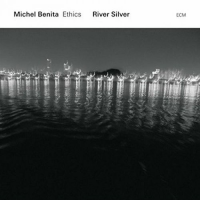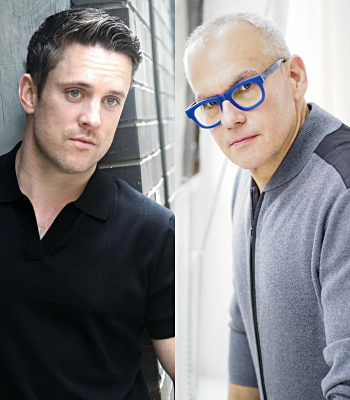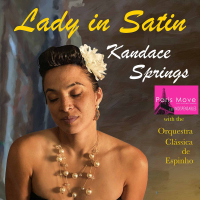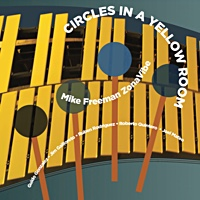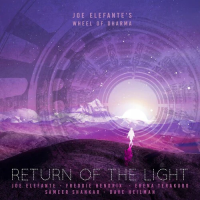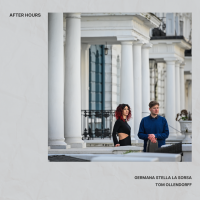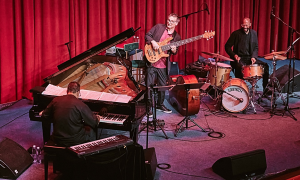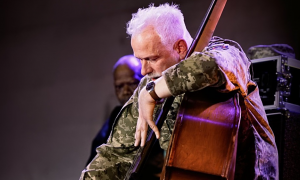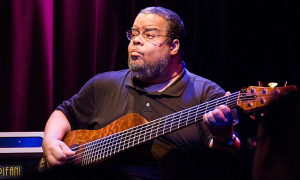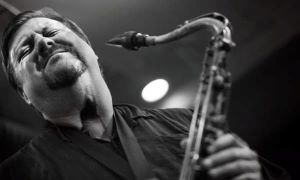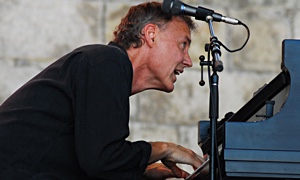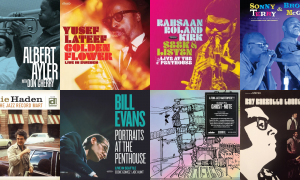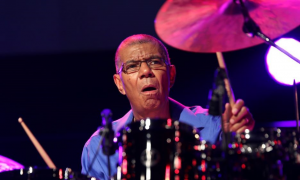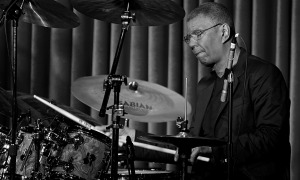Home » Jazz Articles » Profile » Barry Guy: Back to the Drawing-Board (Part 3)
Barry Guy: Back to the Drawing-Board (Part 3)
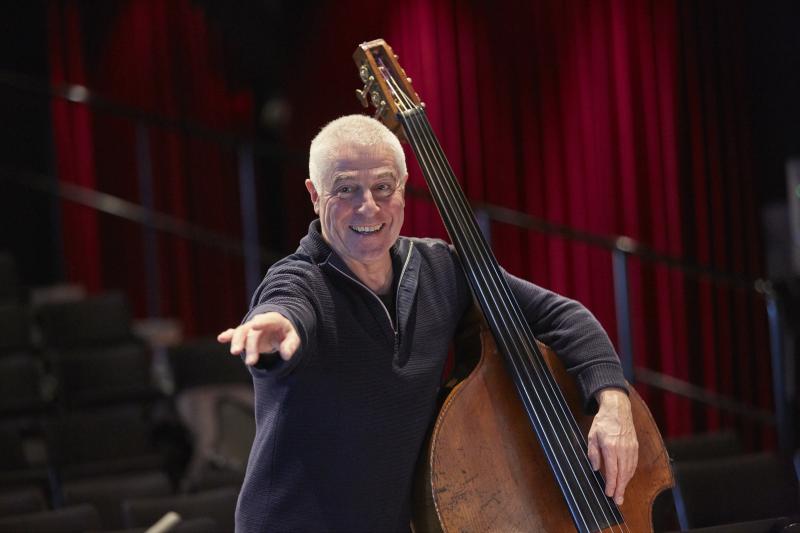
One of the things which may strike the listener on hearing the London Jazz Composers' Orchestra for the first time is just how much volume Guy is able to draw from just seventeen to twenty players. Some other big bands sound almost insipid in comparison. There is something about the way the composer is able to harness the power of his individual musicians and magnify it to something of symphonic orchestral scale—yet without losing subtlety, dynamics and texture.
The Barry Guy New Orchestra, which was founded in 2000 in Dublin is quite a different beast from the LJCO. With ten players, it is considerably smaller and perhaps the analogy of a large chamber ensemble as opposed to an orchestra is a helpful one here. Guy explains the reasoning behind its formation, "The BGNO has a slightly different agenda. Basically, I had to find a smaller band that we felt would be easier to manage on the road, economically. In practice, though it is smaller, the logistics of it are still horrendously difficult. It is an international band with members from so many different countries that there are even more worries about whether people will make a gig." At the same time, as with the Blue Shroud Band, small can be both beautiful and awesome in its own right. That a ten piece ensemble can sound this epic is simply astonishing.
So far, the BGNO has three albums to its name -Inscape—Tableaux (2000), Oort—Entropy (2004) and Amphi -Radio Rondo (2013). Where the size and number of players in the LJCO offered a great deal of scope in terms of coloration—if one trumpet was soloing , two were available to fill out the colours—with the smaller band, new approaches to scoring were needed. Its line-up is essentially three or four reeds, one each of trombone, trumpet and tuba, piano, bass, two percussion and, on Amphi -Radio Rondo Maya Homburger on violin. Guy says that it took him six months to rethink his methodology.
"I wanted to harness everything I had already learned about big band writing but find a way of putting it into a smaller ensemble, retaining the big sound of the LJCO. It was interesting because with the singular players, it meant that the whole sound of the band was big because they weren't having to blend with others in their sections. They were very much individuals who could really deliver huge sounds and who were brilliant improvisers."
The key issue for Guy was the need to refine the writing, so that when an individual was soloing or when a small group was featured the scoring created a full-sounding, consistent and coherent background behind the soloist or group. And this had to be more than just a series of charts or fills. He gives an example of this in relation to Amphi's orchestral background, which draws extensively on Guy's—and Homburger's—love of baroque music and the gorgeous but delicate sound of the baroque violin.
"When Maya was playing, I had to be very careful about the relationship of brass, saxophones and drums to the baroque violin, which could easily have been a complete disaster. But these guys are very accomplished and adjusted the big sound to something much more chamber music-like to give Maya the chance to realise the music I had written for her. It was more like a straight composition but utilising a lot of improvisation. I found that a very interesting lesson. I think as a result, I've refined the orchestration even more with the Blue Shroud band."
The sleeve for Inscape—Tableaux contains a photograph of part of the score for the piece. Containing standard notation, time-space notation and graphic elements it is a thing of beauty in itself. Staring into it, one imagines the infinite possibilities for creative expression and form that it presents to the musicians and their commitment to realising that potential. In the sleevenotes, Guy explains that the group itself is built upon long-standing musical relationships and friendships, There are the trios with Evan Parker and Paul Lytton and that with Swedish saxophonist Mats Gustafsson and percussionist Raymond Strid and by the time the album was recorded in 2000, Guy had recorded twice in trios with pianist Marilyn Crispell, the band's first pianist. Trombonist Johannes Bauer had recorded and worked with the LJCO. That leaves American trumpeter Herb Robertson, Swiss saxophonist/clarinetist Hans Koch and Swedish tuba player Per Ake Holmlander, all of whom were known to Guy personally. The personnel remained pretty much the same for Oort—Entropy and Amphi—Radio Rondo but with Agusti Fernandez replacing Crispell on both and the addition of Swiss saxophonist Jürg Wickihalder on the latter.
The feeling of Inscape—Tableaux is strongly that of European free jazz, albeit tempered by more formal orchestral writing that surfaces at certain points and there is less of an emphasis on the elements from contemporary music so frequently present in the LJCO's oeuvre. However, Guy's ability to juxtapose very different musical ideas is present as ever. With the BGNO, Guy continues to build the whole from smaller groupings within the band but the larger ensemble of the LJCO offered more opportunity to layer different elements or events on top of each other. Here, the emphasise is more on building scale from the juxtapositioning of individual contributions.
Inscape—Tableaux is divided into seven parts. "Part I" features the whole orchestra, at times playing behind one soloist but at others behind freely improvising duos or trios. The orchestral contributions vary from a tonal big band section to far looser interjections. "Part II" opens with a beautifully lyrical, if abstract piano cadenza from Crispell that leads into a duet with Parker matched by periodic dense tone clusters from the orchestra. The use of the orchestra in "Part III" seems to owe much to the more minimalistic textures that were pioneered by the Spontaneous Ensemble in the 1960s, while "Part IV" features primarily Crispell and Guy, solo and in duet. Guy's virtuosic solo leads into a simple, elegiac series of statements from the orchestra that echo again the baroque era. It sounds as natural as breathing. "Part V" might be a shock coming from another source, its frantic, stuttering entry maximises where "Part II" and "part IV" minimised the orchestra's resources. At his heart lie two solos one from Herb Robertson, the other from Johannes Bauer.
However, if the description so far makes the record seem fragmentary, "Part VI" and "Part VII" emphasise the sense of coherence and continuity. "Part VI" could easily stand alone with its mixing of free, abstract playing and highly melodic and romantic composed sections. The playing by Hans Koch on clarinet and Crispell is quite lovely. There is almost a hint of ragtime in the opening of "Part VII" with a series of brief interjections by different players before it develops and expands through a number of short, small group sections. Each of these is brief but in some way recapitulates what has occurred in the earlier sections of the work, not as repetition but more as a reimagining. It builds in volume and pace into a fine piece of free big band jazz, rich in diverse sounds and colours that ends dramatically.
The unique abilities of his musicians lie at the heart of what Guy is seeking to achieve. In a sense, they are the composition, as he explains with a nod to Duke Ellington's famous observation,
"I don't quite know their poker game but I do know what elements will set up a creative passage and I try to harness that in the writing. It's with me as a composer as I'm working away at my desk. When I start creating the architecture of a piece, the faces of the musicians themselves are orbiting the score, as I'm setting out potential pathways. I've been playing with Evan Parker so long now, I know just where to place him in a chart."
He refers to a quote from Renzo Piano, the famous architect, about the "technique of forgetting." For Guy, knowing his musicians is not about repeating the past or about comfort zones but about creating new possibilities for them, about knowing their essence and not just about appreciating their imaginative capacities and technical skills. "Even with the people I know very well, I have to forget what happened before and rediscover a new direction for each of them. But at the back of my unconscious is their sound, their face, their personality, as I try to write something fresh for each player." We mentioned Guy's use of graphic scores. In 1994, Guy was invited to compose for and perform with the Now Orchestra in Vancouver. The result was a piece called Witch Gong Game II/10, which was subsequently reprised with the Glasgow Improvisers Orchestra in 2005 and later released as the CD Falkirk (2006 FMR). The piece was the third in a series, drawing inspiration from the work of Scottish artist Alan Davie, who died in 2014. The first of these, Bird Gong Game was written for Davie, himself a keen musician and improviser. The second, Witch Gong Game was written for and recorded by the Rova Saxophone Quartet on the CD Bingo. Each piece in the series draws upon Davie's distinctive symbolism and the mythologies referenced in his paintings. Guy's stunningly beautiful graphic score incorporates certain of these symbols, notably the Egyptian Ankh representing 'life.'
Or as Guy describes it, "Musical modules hovering over a black void just about touching each other but each module looks as if it could descend into the black hole. I wanted to show this fragility on the score, as well as it being a practical score for playing. I wanted in that score to present something that was absolutely flexible and you can't do that on a lot of pages that you have to keep turning over."
Listening to the NOW and Glasgow Improvisers' Orchestra recordings in close proximity, the similarity of structure is most immediately striking. However, due to the very different instrumentation, timings and roles do not automatically correspond between the two performances. Internally, once more, they are again quite dissimilar. There is perhaps a greater emphasis on the collective on the GIO record, with more of a focus on individual instruments on the NOW version. Perhaps this reflects differing North American and European approaches to jazz and free improvisation. Certainly, one suspects that in respect of GIO, Guy has adapted the music to the orchestra's distinctive performance ethic. Both records contain key Barry Guy signatures. One hears at times the bird-like sounds that seem to echo certain compositions by Olivier Messiaen, the waves of brass, the bop into free jazz big band passages and the occasional almost pastoral section. Cadenzas and small groupings provide important building blocks between events and lead to noir-ish big band episodes or beautiful, pan-tonal orchestral segments. Most importantly both reflect the epic grandeur of Guy's symphonic approach to jazz composition. There is jazz aplenty in both and much else besides for those who care to listen. There is both control and freedom, as Guy seems to indicate, referring to the Now Orchestra recording,
"As I said, with Witch Gong Game II/10, I needed everything in front of me. So, when we came to realise the piece I could take up certain options. I could favour certain parts of the score, which were working successfully and jettison other bits. But I think I got it pretty much right."
And he adds, "I have done it with other people as well. I have found it to be a kind score. It's very flexible and one can adjust the music to different people."
Guy again worked with GIO in 2009 on a new commission, Schweben—Ay, but can ye? (2012 Maya Records). Its inspiration lay in the constructivist art of Russian artist Wassily Kandinsky and a poem by Russian poet Vladimir Mayakovsky, "Can you, really?," which was translated into Glasgow vernacular by Scottish poet Edwin Morgan, as "Ay, but can ye/" The German word, "Schweben" or "to float" is the title of a particular Kandinsky painting. The graphic score itself features thirteen works by Kandinsky, which in turn offer a springboard for the improvisation.
In the main, the players do not so much solo as "float" in and out of the composition, though saxophonists John Burgess and Raymond MacDonald are exceptions here. They are both featured at length over raging, free jazz passages backed by the whole orchestra. Most of all, however, Guy plays to GIO's greatest strength which is its collective identity. Long orchestral sections rise and fall but contain within them fine, angular and fragmentary performances from pianist Gerry Rossi and percussionists Stuart Brown and Rick Bamford. Slow-moving, Messaien-like moments are given delicate colouring by flautists Matthew Studdert-Kennedy and Emma Roche, the guitars of George Burt and Neil Davidson or the trombones of Chris Barclay and George Murray. Later in the piece, voices combine to create a kind of glossolalia over an eerie strings, woodwind and electronic backcloth. But whether individually or collectively performances combine to build the whole composition. It is a music of service, sometimes dark, brooding and powerful and at others delicate, fragile and floating. Schweben—Ay, but can ye? is a wonderful addition to the respective canons of both Guy and the Glasgow Improvisers' Orchestra.
Like all of Guy's extended works, Oort—Entropy tells something of its genesis in its title. "Oort," the sleevenotes explain, is an astronomical term for a "cloud of small rocky icy bodies thought to orbit the sun" beyond Pluto. Here, the word denotes a group of musicians, who boldly go where only the bravest improviser would dare to follow. "Entropy," however, has at least two related meanings—that is, the rate of transfer of information from one place to another and "a measure of the disorder [disordering/rearrangement] of the body." The relationships between the dialectics of order-disorder, control-freedom and creation-dissolution seem to lie at the heart of Guy's approach, a reminder perhaps of the paradox that patterns can be discerned even in apparently chaotic systems.
One pattern on Oort—Entropy is its division into three parts. Another is the fact that it contains within it compositions that Guy wrote for the trio with Marilyn Crispell and Paul Lytton—a clear case of "information transferred from one place to another." In fact, in various ways, the number three seems quite important. Again, the work is built from a series of musical relationships—solos, duos and trios -and juxtapositions to which are then attached other such units. Yet, several trios feature prominently at different times—one with Parker and Lytton; another with Johannes Bauer, Guy and Lytton (or Raymond Strid); a further trio with Fernandez, Guy and Lytton; two different trios, one of Herb Robertson, Mats Gustafsson and Evan Parker and another of Per Ake Holmlander on tuba, Gustafsson and Robertson. I was tempted to ask Guy whether in some way Oort—Entropy could be heard as a sonata, that is as a piece divided into three essential elements -exposition, development and recapitulation. Only cowardice and fear of embarrassment prevailed, though it has something of that flow about it.
The playing is magnificent. The more one hears Paul Lytton in any context the more empathic and intuitive his work appears and the partnership with Raymond Strid is extraordinarily sympathetic. Hans Koch on bass clarinet plays a role in some ways not dissimilar to that of Benny Maupin on Bitches' Brew, the dark, brooding colours of the instrument are a feature here, though its mammalian cries take us into a whole other territory. Fernandez' role is crucial to the work's realisation, a task he performs with an intensity few could match. But, for me, Herb Robertson on trumpet and Per Ake Holmlander stand an inch or so taller on this showing—Robertson for his sheer creativity and range of ideas and Holmlander for the sad, dolorous beauty of his playing. However, this is a collective and the work's success depend on all of the players. At several points the music moves between events with such precision that it is breath-taking. For example, a frantic trio section with Parker (on soprano), Guy and Lytton is joined by the whole orchestra in "Part III" and builds to a crescendo. Instantly, a new section commences with a duo of soprano and piano each matching the trills of the other, as the sotto voce horns carry a largo-like theme. Oort—Entropy is at times a music of extremes—sad, beautiful melodies; shrill cries; fast-paced free jazz; slow-moving, almost minimalist passages. But what a journey it is—and one that seems different each time one travels.
Here, and in all of Guy's compositions, rhythm—perhaps not in any orthodox jazz sense—seems very important. I wondered if the fact that he was a bassist has shaped this aspect of his work.
"I'd never really thought about it but I am interested that you picked up on that. I don't write with the specific idea of rhythm in a conventional sense. I try to have sections move logically in time and space from one area to the next. There is perhaps an overarching rhythmic movement about how and when the music builds or dissipates or how tensions are introduced or relaxed. I think of it more in terms of compositional procedures but within the realisation of any of these pieces, the rhythmic action comes from the players, as improvisers and jazz musicians. Everything has an internal rhythm—it's just the way people play it but I've never been conscious of the relationship between being a bassist and that spinning off into the rhythmic values within the big band piece. Perhaps you've discovered something there."
Amphi—Radio Rondo (2013) comprises two very different pieces. Amphi extends and expands music originally presented on a Guy/Homburger duo recording Tales of Enchantment, which itself was inspired by a series of paintings by American artist Elana Gutmann. Its title, however, is taken from architecture, notably from an amphitheatre-like university building designed by Alvar Aalto in Helsinki that provides space for recreation and study. As always with Guy's compositions, title and inspiration are an essential part of the compositional idea and process of its development and performance. In this sense, the playful element of Amphi is a delight that balances the more demanding aspects for the musicians and listener. It is perhaps the most delightful and charming of all Guy's pieces. In some respects a concerto for baroque violin, Amphi is a tour de force for Maya Homburger. The sheer unadulterated beauty of the instrument's sound, capable of melancholy but also joy, is the primary voice here. Other instruments, whether individually, in group or whole ensemble serve it in some way. The language here owes less to jazz and more perhaps to baroque music and new music, although its improvisatory aspects are strongly evident as well. The textures and colours Guy's musicians produce are less vibrant and striking than in some of his music, more autumnal perhaps. But this is a truly exceptional work beautifully realised here. It could be described as perhaps the greatest baroque composition of the twenty-first century but certainly not as "third stream" music.
The contrast with Radio Rondo could hardly be more marked. Originally written as a "re-awakening" work in 2008 for the LJCO after ten years of silence to feature Irène Schweizer, it was rewritten to feature Agustí Fernández. Here the language is resolutely that of the European jazz avant-garde and non-tonal, though there is a more tonally-structured section led by Fernández from around 15'00"-19'00" with some wide harmonies coming from brass and woodwinds and another shorter tonal passage around 24'30"-27'00." Yet, there are also similarities to Amphi in its construction. As with the Irène Schweizer take, the relationship of the other instruments to the piano is key, just as in the case of Amphi the same applies in respect of the baroque violin. In a way, the other instruments do not solo so much as respond to Fernández, commenting or reflecting back his statements.
There are, however, key differences between the 2008 and 2013 versions. Though the overall structure is essentially the same, on the later take, instruments other than piano are given more space with noteworthy contributions from Matts Gustafsson on baritone, Evan Parker on soprano, Herb Robertson on trumpet and Guy himself. Inevitably, the different instrumentation makes for markedly different textures and more significantly Guy has changed three longish themes on the 2008 recording—one fast-paced and fractious, the next almost adagio, the other elegiac. These either do not feature or are transformed on that made in 2013. On the BGNO album, the quartet section with Parker, Fernandez, Guy and Lytton—on the LJCO release Simon Picard performs this role with Schweizer and rhythm—is lengthened and replaces the first major orchestral passage, the "adagio" is here a more romantic orchestral section and the "elegy" section is missing. The emphasis with the BGNO is on the relationship between the piano and smaller groupings of musicians, whereas that on with the LJCO is more on the piano in an orchestral context. Both, nevertheless, are remarkable performances and worth hearing—and owning -in their own right.
It remains to be seen whether the new direction indicated by the Blue Shroud Band will form the main focus in future for Barry Guy's longer compositions. One would anticipate that the New Orchestra will continue alongside such activity. There can be no doubt that, given the opportunity, Guy would love to see the London Jazz Composers' Orchestra in action again. The issues are that evil combination of time and money. It is a great sadness, a rueful irony and a source of shame that the least likely stages to see and hear the LJCO grace their boards are in the country of Guy's birth. As Evan Parker is wont to remark about himself and other British improvisers, "we rehearse in Britain to play abroad." One thing is certain there will be more long works from Guy and they will find their place alongside duos with Maya Homburger, piano trios, work with Parker and Lytton and Mats Gustafsson and countless other like-minded musicians. And that is more than enough to be thankful for.
Tags
barry guy
Profiles
Duncan Heining
United Kingdom
London
Mats Gustafsson
Raymond Strid
Marilyn Crispell
Johannes Bauer
Herb Robertson
Hans Koch
Per Åke Holmlander
Jürg Wickihalder
NOW Orchestra
Glasgow Improvisers' Orchestra
John Burgess
Raymond MacDonald
Gerry Rossi
Stuart Brown
Rick Bamford
Matthew Studdert-Kennedy
Emma Roche
George Burt
Neil Davidson
Chris Barclay
George Murray
Benny Maupin
PREVIOUS / NEXT
Support All About Jazz
 All About Jazz has been a pillar of jazz since 1995, championing it as an art form and, more importantly, supporting the musicians who make it. Our enduring commitment has made "AAJ" one of the most culturally important websites of its kind, read by hundreds of thousands of fans, musicians and industry figures every month.
All About Jazz has been a pillar of jazz since 1995, championing it as an art form and, more importantly, supporting the musicians who make it. Our enduring commitment has made "AAJ" one of the most culturally important websites of its kind, read by hundreds of thousands of fans, musicians and industry figures every month.




